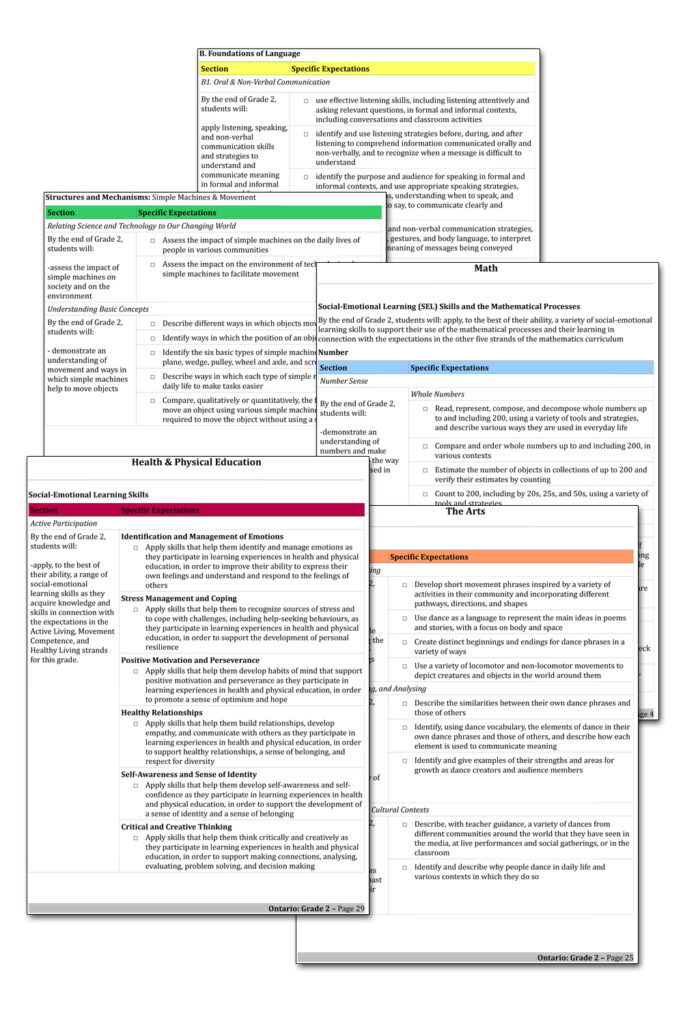Available on my website are some resources known simply as “curriculum checklists.” These are popular downloads for many reasons, but you might be wondering what they are, whether you need to use them as a homeschooler, and how exactly they can be useful.

What are the Curriculum Checklists?
In Canada, education is handled at a provincial level. Decisions about what children should learn at what grade are decided by both the leadership of each province or territory along with experts and professionals, and then compiled together into a collection of learning expectations. These are the foundation for the curriculum provided in the schooling system – a list of what is expected to be taught in each grade.
These documents are then created for the public, whether digitally or in print format, however, they are typically put into a subject based resource as opposed to a grade based one, meaning that anyone wondering what is taught in which grade as do to a little digging. Plus, many times, the document includes lots of professional terms, extra examples, and content, which can also make it challenging to narrow down exactly what to teach and when if you aren’t a trained teacher.
Realizing that the government documentation wasn’t the easiest to use, I began stripping the learning outcomes into an easy-to-use checklist format which brought together each subject in a grade by grade resource. These were intended to be a quick reference, user-friendly guide for anyone to look over and check off as desired.
Do Homeschoolers Need to Follow the Provincial Learning Outcomes Presented in the Curriculum Checklists?
The answer to this question is “probably not.” It really depends on which province you are in, and what your personal preference is for homeschooling. In Ontario, for example, there are no rules obligating you to follow any government specific curriculum plans. Quebec does require homeschoolers to teach their children following their guidelines, and provinces like Alberta and British Columbia vary depending on what route you choose to homeschool.
At the time of this post (2023), you can find curriculum checklists for Ontario, British Columbia, Alberta, and Saskatchewan. We may add more in the future, if there is interest/need.
Why to Use the Curriculum Checklists?
This is the main question – how to actually use the curriculum checklists as a homeschooler. First, figure out if you need or want to follow the learning outcomes provided by the government for your child’s grade.
For those who are following government outcomes:
If you decide to, or have to, follow the learning expectations for your child, these curriculum checklists can be helpful.
- they provide a similar pattern as and parallel learning experience to their peers in public school
- if you are homeschooling your child only short-term (for example, only one year) and want them to be at level when they enroll in school
- you might live in a province where there is the option to have —– and you need to make sure your child is meeting the outcomes
- you might want to enroll your child at school later on so you want to make sure your child is at level when you enroll them
- if you don’t want to follow a purchased curriculum and want to instead check off the skills your child has learned as they learn them
- you want to choose resources that would meet the outcomes so that you know you’ve covered everything
For those who are not following government outcomes
If you don’t want to, or need to, follow the government curriculum plans, here’s how to use the checklists:
- you can check where your child is at periodically to make sure you haven’t missed any topics that could be important to include in your homeschool
- use it as an idea starter while researching curriculum, unit studies, or resources to use in your homeschool
- tracking what your child has learned, perhaps especially in subjects like math or language arts, because it makes you feel more confident in your homeschool
- being aware of what the schools are teaching

How to Use the Curriculum Checklists in Your Homeschool
If you decide to use the checklists as the base for your homeschool, look at the topics covered in your child’s grade and find resources that will help you dig into those topics. For example, in grade one Science in Ontario, students study the differences between living and non-living things, the changes of the seasons, materials for different structures, and more. You can look for resources that cover these topics:
- take books out of the library about these topics
- find a curriculum or unit study
- watch a TV show or documentary about it
- find some hands-on experiments or projects
- go on a field trip to a museum / science centre / community activity
That’s it!
Another Way
Another idea is to simply use whatever curriculum or homeschool method you want and refer back to the checklists to see what your child has learned in alignment with the public school system. It can be interesting to see how and what your child learns through miscellaneous programs and life!
Where to Find The Canadian Provincial Curriculum Checklists
Regardless of whether you are not following the government outcomes or not, the Curriculum Checklists can be useful. You can easily download them from the Canadian Homeschooler Resources Shop for free! Currently, you can find checklists for Ontario, Alberta, British Columbia, and Saskatchewan for grades 1 through 8.
Please note: We have been working on keeping these up-to-date, but this is a continued work-in-progress as governments like to change things frequently.
- How to Keep a Toddler Busy While Homeschooling - March 21, 2024
- 25+ Things Your Kids Learn From Video Games - March 20, 2024
- 10 Words For New Homeschoolers - March 20, 2024
